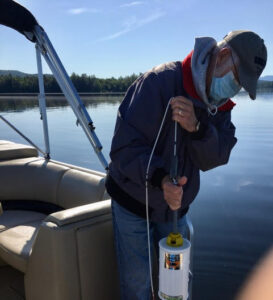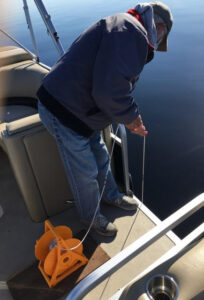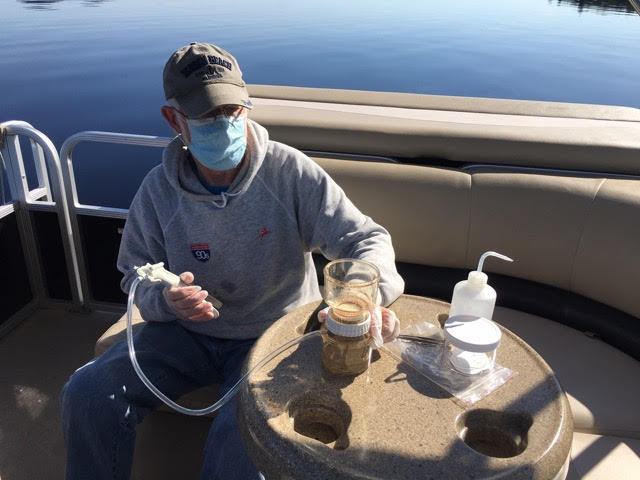Monitoring Lake Quality
RLPF’s Lake Monitoring Program
We currently collect water samples, as well as run some basic water tests, for two water quality monitoring programs. The first is Paul Smith College’s Adirondack Lake Assessment Program (ALAP) . On its website, ALAP describes itself as “a research and monitoring collaboration between scientists and volunteers.” Trained volunteers collect samples from participating lakes, which are sent to Paul Smith’s Adirondack Watershed Institute for analysis. Samples are collected monthly during June, July and August. Key water quality variables, like nutrients and pH, are tested.
Our volunteers have participated in the ALAP program since 2003. As a result, the water quality record for Raquette Lake has matured to the point that trends can now be detected with greater accuracy. For instance, during each sample outing, we measure the transparency, or clarity, of Raquette Lake. Our data suggest that Raquette Lake’s transparency has been decreasing. A similar pattern has been observed in other lakes in the Adirondacks. These decreases are related to a concurrent increase in the concentration of dissolved organic carbon (DOC) in these lakes. DOC is responsible for a lake’s yellow to brown color. It is well documented that higher levels of color (DOC) result in lower transparencies (clarity). The Adirondack Watershed Institute suggests that there are two popular hypothesis for the increase in DOC in some lakes: 1) reduction in acidic deposition (Montieth et al. 2007) and, 2) increased precipitation from climate change (Shindler et al. 1996; Pace and Cole 2002; Gaiser et al. 2009). A key benefit of a long-term water quality record is that trends can be detected and appropriate actions taken to define, and possibly mitigate, negative impacts. You can view the most recent ALAP water quality report here. The annual cost for ALAP is $300.
Our second water quality monitoring program is the Citizens Statewide Lake Assessment Program (CSLAP). CSLAPis a volunteer lake monitoring and education program that is managed by the DEC and the New York State Federation of Lake Associations (NYSFOLA). We decided to participate in CSLAP in 2019 because its monitoring protocol was more extensive than ALAP’s, and all testing is done by a NYSDOH certified laboratory. This latter point will prove beneficial whenever we apply for grants from New York State. As long as we have volunteers willing to do the work, we plan to continue to participate in both programs. You can view the most recent CSLAP water quality report here. The annual cost for CSLAP is $450.
Other organizations also monitor the water quality of Raquette Lake including State University of New York at Cortland, Lebanon Valley College and Hamilton County Soil and Water District (HCSWD). At times, we have worked cooperatively with both of these groups. SUNY Cortland and Lebanon Valley College have surveyed aquatic plants in sections of Raquette Lake since 2005. In 2019, HCSWD released their report “The State of Hamilton County Lakes: A 25-Year Perspective”. This is an excellent report that provides insights on long-term trends. It also permits a side-by-side comparison of water quality with Raquette Lake’s watershed neighbors – Blue Mountain Lake and Long Lake. Another great aspect of HCSWD’s report is that it includes vertical profile data for key variables like dissolved oxygen and temperature measured at one meter intervals from the surface to the bottom of Raquette Lake.
One of the first tasks we identified for our consultant for Raquette’s Lake Management Plan was the need to summarize the historical record on water quality. This past winter (2020) our consultant provided the board with a draft summary for our review and comment. The draft LMP, which should be available by spring 2021, will include a discussion on water quality trends and recommendations for future testing.


